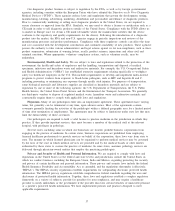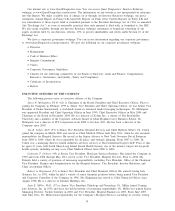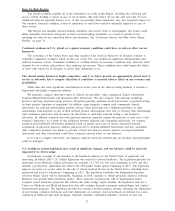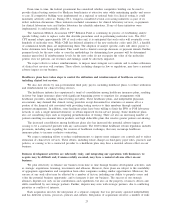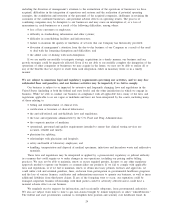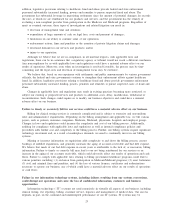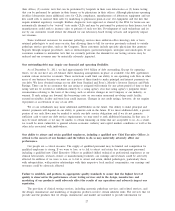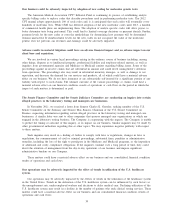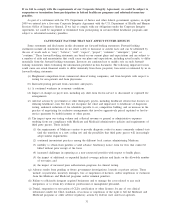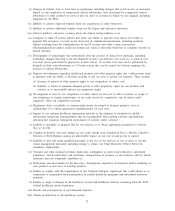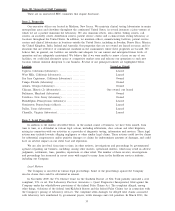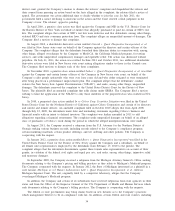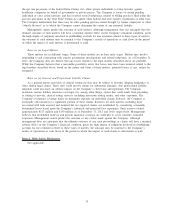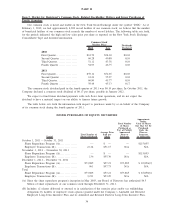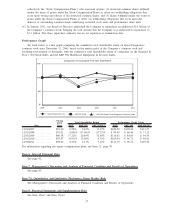Quest Diagnostics 2011 Annual Report Download - page 33
Download and view the complete annual report
Please find page 33 of the 2011 Quest Diagnostics annual report below. You can navigate through the pages in the report by either clicking on the pages listed below, or by using the keyword search tool below to find specific information within the annual report.their offices, (2) esoteric tests that can be performed by hospitals in their own laboratories or (3) home testing
that can be performed by patients in their homes or by physicians in their offices. Although physicians operating
in-office laboratories incur additional costs for CLIA compliance, manufacturers of laboratory equipment and test
kits could seek to increase their sales by marketing to physicians point-of-care test equipment and test kits that
require minimal regulatory oversight. Further, diagnostic tests approved or cleared by the FDA for home use are
automatically deemed to be “waived” tests under CLIA and may be performed by patients in their homes; test kit
manufacturers could seek to increase sales to patients of such test kits. Development of such technology and its
use by our customers would reduce the demand for our laboratory-based testing services and negatively impact
our revenues.
Some traditional customers for anatomic pathology services have added in-office histology labs or have
retained pathologists to read cases on site, thus allowing them to bill for services previously referred to outside
pathology service providers, such as the Company. These customers include specialty physicians that generate
biopsies through surgical procedures, such as dermatologists, gastroenterologists, urologists and oncologists. If our
customers continue to internalize tests that we currently perform, the demand for our testing services may be
reduced and our revenues may be materially adversely impacted.
Our outstanding debt may impair our financial and operating flexibility.
As of December 31, 2011, we had approximately $4.0 billion of debt outstanding. Except for operating
leases, we do not have any off-balance sheet financing arrangements in place or available. Our debt agreements
contain various restrictive covenants. These restrictions could limit our ability to use operating cash flow in other
areas of our business because we must use a portion of these funds to make principal and interest payments on
our debt. We have obtained ratings on our debt from Standard and Poor’s, Moody’s Investor Services and Fitch
Ratings. There can be no assurance that any rating so assigned will remain for any given period of time or that a
rating will not be lowered or withdrawn entirely by a rating agency if in that rating agency’s judgment future
circumstances relating to the basis of the rating, such as adverse changes in our Company or our industry, so
warrant. If such ratings are lowered, the borrowing costs on our senior unsecured revolving credit facility,
secured receivables facility and term loan could increase. Changes in our credit ratings, however, do not require
repayment or acceleration of any of our debt.
We or our subsidiaries may incur additional indebtedness in the future. Our ability to make principal and
interest payments will depend on our ability to generate cash in the future. If we incur additional debt, a greater
portion of our cash flows may be needed to satisfy our debt service obligations and if we do not generate
sufficient cash to meet our debt service requirements, we may need to seek additional financing. In that case, it
may be more difficult, or we may be unable, to obtain financing on terms that are acceptable to us. As a result,
we would be more vulnerable to general adverse economic, industry and capital markets conditions as well as the
other risks associated with indebtedness.
Our ability to attract and retain qualified employees, including a qualified new Chief Executive Officer, is
critical to the success of our business and the failure to do so may materially adversely affect our
performance.
Our people are a critical resource. The supply of qualified personnel may be limited and competition for
qualified employees is strong. If we were to lose, or to fail to attract and retain, key management personnel,
including a qualified new Chief Executive Officer or qualified skilled technical or professional employees at our
clinical laboratories, research centers or manufacturing facilities, our earnings and revenues could be adversely
affected. In addition, if we were to lose, or to fail to attract and retain, skilled pathologists, particularly those
with subspecialties, with positive relationships with their respective local medical communities, our earnings and
revenues could be adversely affected.
Failure to establish, and perform to, appropriate quality standards to assure that the highest level of
quality is observed in the performance of our testing services and in the design, manufacture and
marketing of our products could adversely affect the results of our operations and adversely impact our
reputation.
The provision of clinical testing services, including anatomic pathology services, and related services, and
the design, manufacture and marketing of diagnostic products involve certain inherent risks. The services that we
provide and the products that we design, manufacture and market are intended to provide information for
27


